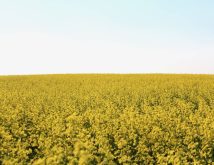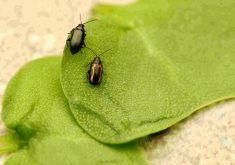The Canola Council of Canada is encouraging farmers to hold off on harvesting canola to improve yield.
Research in the early 2000s showed that canola swathed at 60-70 per cent seed colour change (SCC) yielded 11 per cent more than fields swathed at 30-40 per cent.
That research was reinforced in 2013, when the Indian Head Agricultural Research Foundation compared two swath timings – 20-30 per cent and 50-60 per cent SCC – and found that waiting a week until canola reached the more advanced stage increased yields by nearly nine per cent.
Read Also

Manitoba boosts stake in cereals centre to $23.5 million
Premier Wab Kinew said the additional project funds will help ‘Trump-proof’ the provincial economy.
Further trials, done by BASF, found that 60 per cent SCC is the “sweet spot” for hybrids without the pod-shatter trait. For hybrids with the pod-shatter trait, BASF trials showed higher yields for canola swathed at 80 per cent and highest yields for canola straight combined.
“It was something that I talked about more about 10 years ago,” said Shawn Senko, an agronomy specialist with the canola council. “It felt like it was picked up well, and then we saw in 2020 that a lot of producers were still swathing early.”
In 2020, a survey of 1,000 growers showed that, despite accessible information from the council’s website, 51 per cent of canola farmers were not heeding the advice. So, the council launched its latest campaign to raise awareness about the benefits of delaying harvest.
Senko says the survey wasn’t clear on whether farmers were unaware of the benefits of waiting to harvest, or whether they were ignoring them due to issues such as time-management challenges at harvest time.
“Producers are always under time constraints,” he says. “Growers may have reasons to cut early based on frost risk and logistics, but where possible, we’d like to see the target shift to later cutting. Especially under today’s commodity costs, that 10 per cent yield difference is significant.”
What to look for
Senko said at 60 per cent SCC on the main stem, seeds from the bottom third of the stem will have completely turned brown-black. Seeds from the middle third will be mostly brown, with some speckling and mottling. Seeds from the top third will still be green but firm to roll. Seeds that are mushy when rolled between the thumb and finger are not mature and will shrivel up after cutting.
“With the main stem showing this level of maturity, seeds inside branches should also be firm to roll. If they’re not, growers may want to leave the field standing a little longer,” says Senko. SCC will typically increase by about 10 percentage points every two or three days, and quicker under hot, dry conditions, or slower under cool, moist conditions.
“So, waiting a week can provide a big boost in yield and potential profit,” he said.
One of the challenges in assessing the 60 per cent threshold is variability within a field.
“It might look like it’s 60 per cent or more, but there could be a lot of green areas in that field,” Senko said. “It’s not always that simple to assess. Make sure you’re assessing the entire field.”
Swathing is the best and least risky option to manage extreme variation in maturity, but he suggests uneven crops could be left for straight combining.
“While early-maturing plants may start to shell out, late-maturing plants have more time to mature. Straight combining eliminates the need to make the swath timing decision at all.”
Of the farmers who participated in the 2020 CCC survey, 19 per cent straight combine all their canola acres.
The canola council launched its awareness campaign in early August, and Senko said it will monitor the situation.
“We definitely want to re-survey and see if these campaigns have helped.”
















